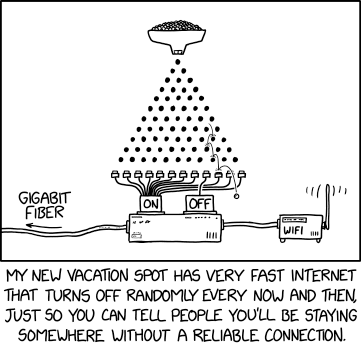Difference between revisions of "User:ColorfulGalaxy/Sandbox"
(Created page with "{{2659}}") |
|||
| Line 1: | Line 1: | ||
| − | {{comic | + | 💣{{comic |
| number = 2659 | | number = 2659 | ||
| date = August 15, 2022 | | date = August 15, 2022 | ||
Revision as of 02:11, 14 April 2023
| Unreliable Connection |
 Title text: NEGATIVE REVIEWS MENTION: Unreliable internet. POSITIVE REVIEWS MENTION: Unreliable internet. |
Explanation
In today's world, the Internet, pervasive mobile technology and the COVID pandemic have all caused an implicit expectation for many people to be available all hours of the day, whether for work or social communications, even when on vacation. In this comic, Randall addresses the issue with a deliberately suboptimal internet device that drops Internet connectivity intermittently and at unpredictable intervals, thereby causing activities that require a constant, uninterrupted connection to be unusable. The device appears to be an internet modem connected to an automated version of a Galton board or Jin Akiyama's mathematical pachinko machine[1] with a series of twelve switches at the bottom to be pressed by falling balls, eleven of which are linked to a the label "on" and one linked to a second label "off," both such sets of switches apparently controlling the connection. This solves the social problem of demands for the likes of synchronous teleconferencing, by causing asynchronous methods of communication to be relatively more reliable and efficient for personal use.
This is funny because such a device could likely much more easily be implemented in the firmware of the internet or WiFi modem or routers. (See 1785: Wifi for an explanation of firmware.) It's not clear whether the switches merely interrupt the connection momentarily or control power to the modem, which would involve a much longer booting sequence. The "unreliable" connection provides an excuse to be unavailable for work or social calls, and thus free to enjoy one's vacation. However the device also allows the user to have a fast internet connection most of the time, enabling them to use it for leisure purposes, such as downloading movies for entertainment, or to connect with others on one's own terms. It thus retains most of the benefit of a good connection.
The probability of a ball hitting the "off" switch is 165/2048, or about 8% (assuming the machine is ordinary,[2] and the space between switches is disregarded) because it's in the ninth position. We don't know the frequency with which new balls are dropped, so we can't estimate the frequency at which the device is likely to trigger Session Initiation Protocol, Transmission Control Protocol, or similar timeout conditions that would likely close synchronous VOIP, video conferencing, and e.g. VRChat connections. Even if such connections were to survive the induced service interruptions, the application layer call or teleconference quality would suffer during them. The device may cause interruptions rarely enough that the connection is usable for casual purposes, but the user can still reasonably claim that it's unreliable to get out of online obligations.
The title text reflects on today's increasingly always-connected world, where emphasis may be changing from finding rare vacation spots that have reliable internet, to now finding somewhere worthwhile to go that still doesn't have it. It could also be a comment on the mild paradox that a nominally unreliable internet connection has advantages for those whose communication schedule, volume, or style preferences make synchronous teleconferencing less practical, desirable, or both. The reviews for the new vacation spot indicate that disconnections are found to be both desirable and undesirable, possibly even by the same person.
Transcript
| |
This transcript is incomplete. Please help editing it! Thanks. |
- [There are twelve switches under an automated Galton board or pachinko machine, eleven of which are linked to a large item marked "on" but the ninth of which is linked to one marked "off", apparently controlling the operation of a modem connected to a gigabit data-cable and also connected onwards to a WiFi router. There is a supply of balls in a hopper above the board, with the triangular configuration of pins directing the balls chaotically to one or other of the switches, as shown by a single released ball and a motion path partially showing how it had rebounded from around half-way down until after hitting and rebounding away off a bottom-layer "on" switch.]
- [Caption below the panel]:
- My new vacation spot has very fast internet that turns off randomly every now and then, just so you can tell people you'll be staying somewhere without a reliable connection.
Discussion
No comments yet!
